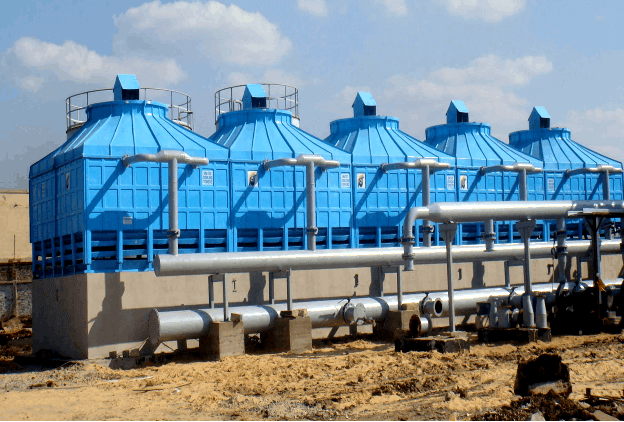Efficient operation of a cooling tower is very important in industries that require a consistent temperature regulation, such as manufacturing plants and HVAC systems. Its adequate functioning not only enhances performance but also minimises energy consumption, water, and maintenance expenses.
This guide will provide you with practical and proven best practices to ensure that you get the highest level of cooling tower efficiency, and at the same time, ensure long-term reliability and sustainability.
Why Efficient Cooling Tower Operation Is Important?
Cooling towers play a vital role in cooling the extra heat, and therefore, poor performance may result in higher energy expenses, water wastage, and damage to the system. The application of intelligent operational practices will guarantee:
- Reduced the costs of utility and maintenance
- Longer equipment lifespan
- Stable performance throughout the year
A well-controlled cooling tower is economically and environmentally sustainable.
Best Practices for Efficient Cooling Tower Operation
The following best practices will help you maximize cooling tower efficiency and reliability.
Identify and Control Water Loss
Water loss is one of the most common challenges in cooling tower operation. Understanding and managing it effectively improves overall system efficiency.
- Evaporation: This is the natural cooling process in which water is converted into vapour.
- Drift: Minuscule water droplets that are swept away by exhaust gases; this is reduced by exhaust gas cleaners.
- Blowdown (Bleed-off): Mineral build-up is avoided by a discharge that is controlled and has a controlled amount.
- Leaks and Overflows: Leaks that are not intended and occur due to faulty valves, cracks, and malfunctioning floats.
You can save makeup water and reduce operational expenses by keeping track of and controlling such losses.
Optimise Water Quality and Cycles of Concentration
Good water quality helps in avoiding corrosion, scaling, and biological growth, all of which decrease efficiency.
- Proper water treatment is used to balance the pH and hardness.
- Use side-stream filtration to remove suspended solids.
- Chemical dosing should be maintained correctly, and water should be tested regularly.
Regular checking of the conductivity or TDS (Total Dissolved Solids) assists in the maximisation of the concentration cycle, enabling you to minimise the quantity of blowdown and save on water.
Keep Fill Media and Drift Eliminators Clean
The dirty filter media inhibits the free flow of air and decreases the efficiency of heat transfer. Drift eliminators that are blocked with debris would lead to one-sided water distribution and decreased performance.
- Periodically clean fill media to get rid of dirt, scale, and algae.
- Check drift eliminators and louvers in case there is any obstruction.
- Have periodic tower cleaning and disinfection to manage the growth of bacteria.
A clean tower improves the airflow, optimises the cooling, and maintains stable operation.
Improve Blowdown and Makeup Water Management
Effective management of blowdown is necessary to keep the balance of minerals minimal with a minimum of water wastage.
- Regulate discharge with automatic blowdown controllers, which regulate discharge based on conductivity readings.
- Automate valves instead of doing it manually to be more accurate.
- Adjust blowdown rates based on system load and ambient weather conditions.
Proper management of blowdown ensures optimal water chemistry and a low cost of chemicals and water.
Inspect Mechanical Components for Maximum Performance
The operation of a cooling tower requires that it work efficiently in a mechanical way. Mechanical maintenance should be done regularly to maintain constant air movement and heat transfer.
- Motors, bearings, and fan blades should be kept clean and oiled.
- Balance fans and check belt tension to prevent vibration.
- Install Variable Frequency Drives (VFDs) in order to synchronise the speed of the fans to the system demand.
- Make sure that there are nozzles and spray systems that are unevenly distributed.
These measures minimise the use of energy and increase the cooling tower efficiency.
Conduct Routine Inspections and Preventive Maintenance
Preventive maintenance would be important in the prevention of expensive repairs and continuity in operation.
- Check basins, piping, and nozzles, looking for leaks or corrosion.
- Keep an eye on the conditions of water and water flow weekly.
- Complete before optimal cooling demand. Book maintenance seasonally.
- Train drivers to spot when there is inefficiency.
With proactive maintenance, the cooling tower will be more reliable, efficient, and the life of the cooling tower will improve.
Enhance Airflow and Tower Design Efficiency
Enhancement of air flow is a guarantee of optimum heat rejection and reduction of energy consumption.
- Keep air inlets and outlets free from obstructions.
- Check fan motors and shafts to ensure they are smooth.
- Fix broken fan blades and also the louvres.
- Long-term savings improve the energy efficiency of fans or tower designs.
The increased airflow enhances cooling capability and maintains the constant system performance in different conditions.
Final Thoughts
Smart water management, regular maintenance, and optimised airflow are the keys to the efficient operation of cooling towers. These best practices will help to enhance performance, lower operating expenses, and attain long-term sustainability. At TowerTech India, we offer advanced cooling tower solutions engineered for superior durability, energy efficiency, and low water consumption.


